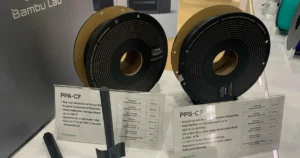Natural fibers like cellulose are revolutionizing 3D printing by reinforcing plastics for stronger, more sustainable products.
Plastic polymers, long praised for their versatility, are getting a power-up—this time, thanks to natural fibers like cellulose. These fibers, alongside other natural alternatives, are stepping up to reinforce commonly used thermoplastic polymers, including polylactic acid (PLA) and polyamide (PA), which are staples in FDM 3D printing. While carbon and glass fibers have traditionally held the spotlight, their abrasiveness and potential health risks are prompting a shift toward safer, more sustainable alternatives.
Cellulose Enters the Ring
In a notable move, cellulose is gaining traction. As a natural fiber, it’s capable of transforming PLA into a biocomposite, addressing the material’s infamous brittleness while remaining fully plant-based. Research shows that the addition of just 1% sisal-based cellulose nanofiber to PLA leads to impressive gains—boosting tensile strength by 84% and improving the material’s modulus by 63%. It’s a game-changer for 3D printing, which often struggles with weak layer adhesion and voids in printed objects.
Basalt: A Silent Contender
Cellulose isn’t alone in this fiber revolution. Basalt, a silicate-based mineral fiber, is emerging as a replacement for traditional glass fibers in insulation and composites. It is more chemically stable, absorbing less moisture, and less abrasive than the ones that it replaced. However, questions remain about the long-term health effects of inhaling fine basalt particles. While not as dangerous as asbestos, there’s still some caution in the air.

A Greener Future with Lignin
Lignin, another natural material, is also showing promise in reinforcing PLA composites, particularly when combined with cellulose nanofibers. The duo not only improves mechanical properties but also offers UV stabilization—a big win for outdoor 3D-printed products. Research continues into making lignin-based PLA composites even more efficient, with new studies focusing on improving the dispersion of lignin nanoparticles.
End-of-Life Considerations
As exciting as these advances are, they don’t fully solve the problem of what happens when these biocomposites reach the end of their life cycle. While cellulose and lignin biodegrade easily, PLA still faces challenges, requiring industrial composting to break down efficiently. Despite this, the overall impact of natural fiber-reinforced plastics seems to outshine their synthetic counterparts, offering a glimmer of hope for a more sustainable future in plastic production.
Nestor Sawayn is a U.S.-based tech journalist specializing in maker tools and creative technologies. His coverage spans 3D printers, vinyl cutters, paper printers, and laser cutters across North America, Europe, and Asia. Sawen’s articles offer concise, insightful analysis of the latest News, innovations in this space. Beyond hardware, he explores the creative potential of board games and tabletop RPGs, providing readers with a comprehensive view of both digital and analog maker trends.
Feel free to reach out to me at nestorsawayn@360techinsights.com.




